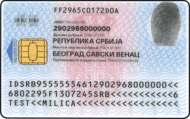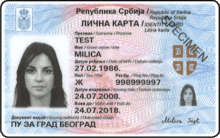Serbian identity card
| Serbian identity card (Lična Karta) | |
|---|---|
 | |
 | |
| Issued by |
|
| Valid in |
|
| Type of document |
Identity card, optional replacement for passport in the listed countries |
| Eligibility requirements | 10 years of age |
Serbian identity card (Serbian: Лична карта / Lična karta) is the national identification card used in Serbia. Though the ID card is a primary photo ID, Serbian passport and national Drivers license are used as valid photo IDs for various purposes. It is issued to all Serbian citizens residing in the country above 10 years of age, while it's compulsory for those over the age of 16.[1]
Appearance


ID card has the same shape and size as many other ID cards, as specified by the ISO/IEC 7810 standard. It features a light red and blue background, colors of the Serbian flag. Obverse background has a picture of a statue on the top of the Serbian government building in Belgrade, while the reverse has the small Serbian coat of arms.
In the chipped card, language used on the form is Serbian (in Cyrillic script) and English, however, personal data is printed only in Serbian Cyrillic. This has caused some controversy, since obviously national ID card will be difficult to use as a valid ID document abroad, except in those countries which also use Cyrillic script. Nevertheless, the chip-less version of the ID card uses Latin and Cyrillic scripts and has the holder's name printed in Latin script. This was done probably due to the fact that the name of the ID card holder is stored in Latin script inside the chip of a chipped card.
Serbian citizens who are members of a national minority have the option to have the form of their ID card printed in Serbian, English and their native language (or Serbian Latin), while personal data will be entered in native language (for example, for Serbian Hungarians, in Latin script Hungarian alphabet, instead of the Serbian Cyrillic). Citizens whose native language is Serbian can opt to have their personal data entered in Serbian Latin, instead of Cyrillic script; however, ID card form will still be in Serbian Cyrillic and English only, as Serbian Latin and Serbian Cyrillic are not considered different languages.
ID card includes the following data:
- Презиме / Surname
- Име / Given name
- Датум рођења / Date of birth
- Пол / Sex
- Рег. бр. / Reg No
- Датум издавања / Issuing date
- Важи до / Valid until
- Документ издаје / Issuing authority
- ЈМБГ / JMBG
- Држава рођења / State of birth
- Место и општина рођења / Place of birth
- Пребивалиште и адреса стана / Place of residence (not included on the biometric ID cards)
Bearers signature and fingerprint of the right index finger are also printed on the ID card.
Validity of the document is ten years from the date of handing in the application, while processing time is up to 15 days.
Announced changes
On July 1, 2013, Serbian Ministry of the Interior announced that there will be certain changes in the design and features of the ID[2] in 2014. Among other things, there is a plan to improve the quality of the holder's photo. All new IDs will contain contact chip (until now there was a possibility of opt out for the chip) and there will also be a RFID chip incorporated in the design. The ID will be readable by passport readers and it could be programmed to contain holder's electronic signature, health insurance data, public transport subscription information, as well as, information usually contained in a driving licence. E-government portals will be made compatible with the new ID design.
Machine readable zone
The data of the machine readable zone consist of three lines of 30 characters each. The only characters used are those of Serbian Latin alphabet, except for letters with diacritics (ŠĐĆČŽ - they are replaced by the appropriate letter without a diacritical mark), 0-9 and the filler character <.
The format of the first row is:
| Positions | Type | Meaning |
|---|---|---|
| 1-2 | alpha | ID, indicating an ID card |
| 3-5 | alpha | Issuing country (ISO 3166-1 alpha-3) code (SRB) |
| 6–14 | num | ID card registration number |
| 15 | num | check digit |
| 16-28 | num | Personal number (JMBG) |
The format of the second row is:
| Positions | Type | Meaning |
|---|---|---|
| 1–6 | num | Date of birth (YYMMDD) |
| 7 | num | check digit |
| 8 | alpha | gender (M-male; F - female) |
| 9-14 | num | Date of expiry (YYMMDD) |
| 15 | num | check digit |
| 16-18 | num | Nationality of bearer ISO 3166-1 alpha-3 code (SRB) |
| 30 | num | check digit |
The format of the third row is:
| Positions | Type | Meaning |
|---|---|---|
| 1–30 | alpha | Last name, followed by two filler characters, followed by given names |
Chip

After a long public debate, it has been decided that people will have an option to choose whether to have an ID card with or without the chip, containing the data already printed on the ID card. Those opting for the chip card do not have their place of residence (home address) printed, but it is stored in the chip. The police has provided the public with freeware software to download the data from any ID card to a computer (except for the scanned signature and the fingerprint) using a standard smart card reader.[3] Serbian ID does not feature contactless RFID chip, so it is not a fully ICAO9303 compliant biometric travel document. About two thirds of citizens applying for the ID card opt for the chipped version.[4]
Requirements
To acquire the biometric ID card for the first time, a citizen must present a birth certificate and a proof of citizenship, as well as the expired old style Lična karta. In case of a renewal, only taxes should be paid and new photo will be taken at the police station.[5]
International travel
Serbian identity card can be used instead of a passport for travel to some neighboring countries (and territories) of Serbia that have signed special agreements(†) with the Serbian Government:
| Countries (and territories) | Agreement / Stay |
|---|---|
| 90 days | |
| 90 days | |
| 30 days | |
| 30 days | |
See also
- Serbian passport
- Serbian nationality law
- Visa policy of Serbia
- Visa requirements for Serbian citizens
- List of identity card policies by country
References
- ↑ The Serbian Law on ID card
- ↑ http://www.blic.rs/Vesti/Drustvo/390971/Nove-licne-karte-od-sledece-godine
- ↑ Sertifikaciono telo MUP-a Republike Srbije PREUZIMANJE SOFTVERA (Serbian)
- ↑ Nove lične karte nečitljive Politika, Retrieved 22 Aug 2008 (Serbian)
- ↑ Biometrijska lična karta Ministry of Interior, Republic of Serbia (Serbian)
- ↑ http://www.mfa.ba/konzularne_informacije/vize/Default.aspx
- ↑ http://www.mfa-ks.net/?page=2,158
- ↑ http://www.mfa.gov.mk/index.php/en/for-foreign-nationals/entry-visa-for-the-republic-of-macedonia/entry-visa-for-the-republic-of-Macedonia
- ↑ http://www.mvpei.gov.me/en/sections/consular-affairs/visa-regimes-for-foreign-citizens/serbia
External links
- Informisanje.info - A procedure on applying for and issuing Serbian identity card (Serbian)